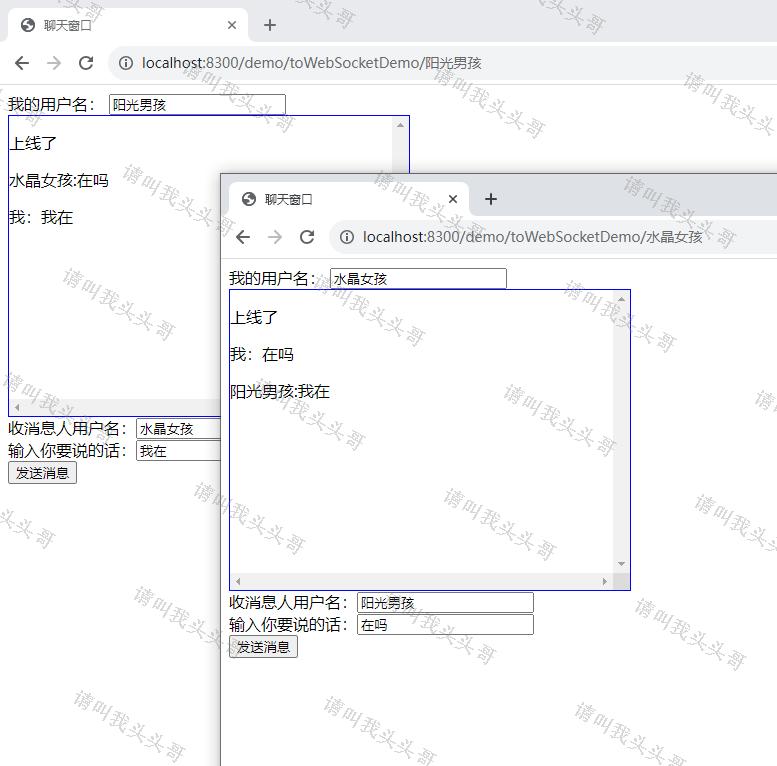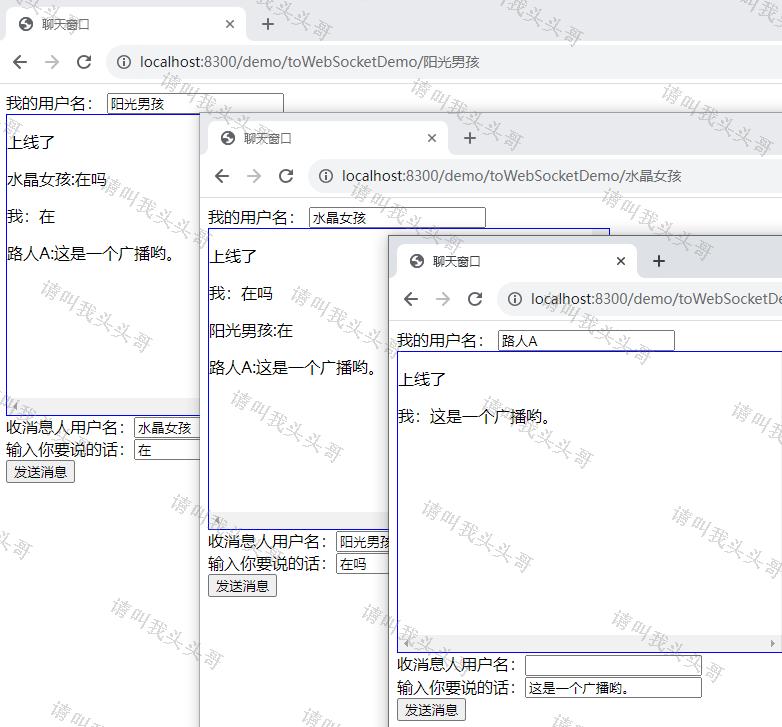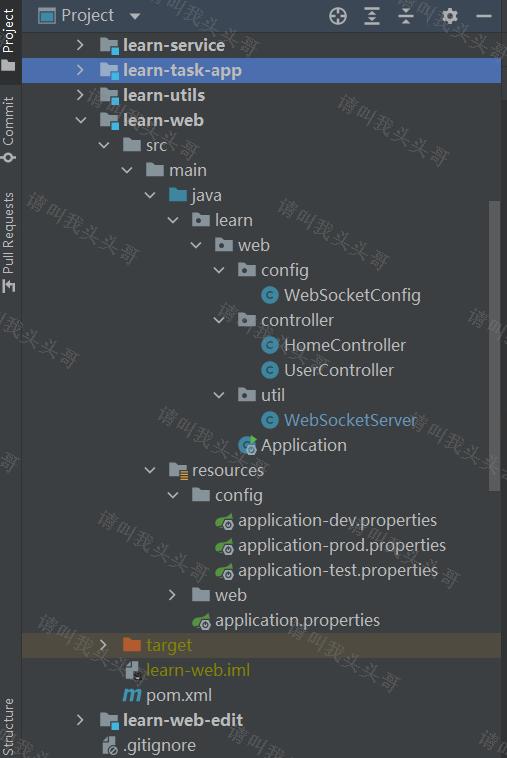WebSocket是一种在单个TCP连接上进行全双工通信的协议。WebSocket使得客户端和服务器之间的数据交换变得更加简单,允许服务端主动向客户端推送数据。在WebSocket API中,浏览器和服务器只需要完成一次握手,两者之间就直接可以创建持久性的连接,并进行双向数据传输。
v原理
很多网站为了实现推送技术,所用的技术都是轮询。轮询是在特定的时间间隔(如每1秒),由浏览器对服务器发出HTTP请求,然后由服务器返回最新的数据给客户端的浏览器。这种传统的模式带来很明显的缺点,即浏览器需要不断的向服务器发出请求,然而HTTP请求可能包含较长的头部,其中真正有效的数据可能只是很小的一部分,显然这样会浪费很多的带宽等资源。
而比较新的技术去做轮询的效果是Comet。这种技术虽然可以双向通信,但依然需要反复发出请求。而且在Comet中,普遍采用的长链接,也会消耗服务器资源。
在这种情况下,HTML5定义了WebSocket协议,能更好的节省服务器资源和带宽,并且能够更实时地进行通讯。
v架构搭建
添加maven引用
<dependency> <groupId>org.springframework.boot</groupId> <artifactId>spring-boot-starter-websocket</artifactId> </dependency> <dependency> <groupId>org.springframework.boot</groupId> <artifactId>spring-boot-starter-thymeleaf</artifactId> </dependency>
配置应用属性
server.port=8300
spring.thymeleaf.mode=HTML
spring.thymeleaf.cache=true
spring.thymeleaf.prefix=classpath:/web/
spring.thymeleaf.encoding: UTF-8
spring.thymeleaf.suffix: .html
spring.thymeleaf.check-template-location: true
spring.thymeleaf.template-resolver-order: 1
添加WebSocketConfig
package com.test.config; import org.springframework.context.annotation.Bean; import org.springframework.context.annotation.Configuration; import org.springframework.web.socket.config.annotation.EnableWebSocket; import org.springframework.web.socket.server.standard.ServerEndpointExporter; /** * @Author chen bo * @Date 2023/10 * @Des */ @Configuration public class WebSocketConfig { /** * bean注册:会自动扫描带有@ServerEndpoint注解声明的Websocket Endpoint(端点),注册成为Websocket bean。 * 要注意,如果项目使用外置的servlet容器,而不是直接使用springboot内置容器的话,就不要注入ServerEndpointExporter,因为它将由容器自己提供和管理。 */ @Bean public ServerEndpointExporter serverEndpointExporter() { return new ServerEndpointExporter(); } }
添加WebSocket核心类
因为WebSocket是类似客户端服务端的形式(采用ws协议),那么这里的WebSocketServer其实就相当于一个ws协议的Controller
直接@ServerEndpoint("/imserver/{userId}") 、@Component启用即可,然后在里面实现@OnOpen开启连接,@onClose关闭连接,@onMessage接收消息等方法。
新建一个ConcurrentHashMap用于接收当前userId的WebSocket或者Session信息,方便IM之间对userId进行推送消息。单机版实现到这里就可以。集群版(多个ws节点)还需要借助 MySQL或者 Redis等进行订阅广播方式处理,改造对应的 sendMessage方法即可。
package com.test.util; import com.google.gson.JsonParser; import lombok.extern.slf4j.Slf4j; import org.springframework.stereotype.Component; import javax.websocket.*; import javax.websocket.server.PathParam; import javax.websocket.server.ServerEndpoint; import java.util.Map; import java.util.concurrent.ConcurrentHashMap; import java.util.concurrent.atomic.AtomicInteger; import com.google.gson.JsonObject; /** * WebSocket的操作类 * html页面与之关联的接口 * var reqUrl = "http://localhost:8300/websocket/" + cid; * socket = new WebSocket(reqUrl.replace("http", "ws")); */ @Component @Slf4j @ServerEndpoint("/websocket/{sid}") public class WebSocketServer { /** * 静态变量,用来记录当前在线连接数,线程安全的类。 */ private static AtomicInteger onlineSessionClientCount = new AtomicInteger(0); /** * 存放所有在线的客户端 */ private static Map<String, Session> onlineSessionClientMap = new ConcurrentHashMap<>(); /** * 连接sid和连接会话 */ private String sid; private Session session; /** * 连接建立成功调用的方法。由前端<code>new WebSocket</code>触发 * * @param sid 每次页面建立连接时传入到服务端的id,比如用户id等。可以自定义。 * @param session 与某个客户端的连接会话,需要通过它来给客户端发送消息 */ @OnOpen public void onOpen(@PathParam("sid") String sid, Session session) { /** * session.getId():当前session会话会自动生成一个id,从0开始累加的。 */ log.info("连接建立中 ==> session_id = {}, sid = {}", session.getId(), sid); //加入 Map中。将页面的sid和session绑定或者session.getId()与session //onlineSessionIdClientMap.put(session.getId(), session); onlineSessionClientMap.put(sid, session); //在线数加1 onlineSessionClientCount.incrementAndGet(); this.sid = sid; this.session = session; sendToOne(sid, "上线了"); log.info("连接建立成功,当前在线数为:{} ==> 开始监听新连接:session_id = {}, sid = {},。", onlineSessionClientCount, session.getId(), sid); } /** * 连接关闭调用的方法。由前端<code>socket.close()</code>触发 * * @param sid * @param session */ @OnClose public void onClose(@PathParam("sid") String sid, Session session) { //onlineSessionIdClientMap.remove(session.getId()); // 从 Map中移除 onlineSessionClientMap.remove(sid); //在线数减1 onlineSessionClientCount.decrementAndGet(); log.info("连接关闭成功,当前在线数为:{} ==> 关闭该连接信息:session_id = {}, sid = {},。", onlineSessionClientCount, session.getId(), sid); } /** * 收到客户端消息后调用的方法。由前端<code>socket.send</code>触发 * * 当服务端执行toSession.getAsyncRemote().sendText(xxx)后,前端的socket.onmessage得到监听。 * * @param message * @param session */ @OnMessage public void onMessage(String message, Session session) { /** * html界面传递来得数据格式,可以自定义. * {"sid":"user","message":"hello websocket"} */ JsonObject jsonObject = JsonParser.parseString(message).getAsJsonObject(); String toSid = jsonObject.get("sid").getAsString(); String msg = jsonObject.get("message").getAsString(); log.info("服务端收到客户端消息 ==> fromSid = {}, toSid = {}, message = {}", sid, toSid, message); /** * 模拟约定:如果未指定sid信息,则群发,否则就单独发送 */ if (toSid == null || toSid == "" || "".equalsIgnoreCase(toSid)) { sendToAll(msg); } else { sendToOne(toSid, msg); } } /** * 发生错误调用的方法 * * @param session * @param error */ @OnError public void onError(Session session, Throwable error) { log.error("WebSocket发生错误,错误信息为:" + error.getMessage()); error.printStackTrace(); } /** * 群发消息 * * @param message 消息 */ private void sendToAll(String message) { // 遍历在线map集合 onlineSessionClientMap.forEach((onlineSid, toSession) -> { // 排除掉自己 if (!sid.equalsIgnoreCase(onlineSid)) { log.info("服务端给客户端群发消息 ==> sid = {}, toSid = {}, message = {}", sid, onlineSid, message); toSession.getAsyncRemote().sendText(message); } }); } /** * 指定发送消息 * * @param toSid * @param message */ private void sendToOne(String toSid, String message) { // 通过sid查询map中是否存在 Session toSession = onlineSessionClientMap.get(toSid); if (toSession == null) { log.error("服务端给客户端发送消息 ==> toSid = {} 不存在, message = {}", toSid, message); return; } // 异步发送 log.info("服务端给客户端发送消息 ==> toSid = {}, message = {}", toSid, message); toSession.getAsyncRemote().sendText(message); /* // 同步发送 try { toSession.getBasicRemote().sendText(message); } catch (IOException e) { log.error("发送消息失败,WebSocket IO异常"); e.printStackTrace(); }*/ } }
添加controller
package com.test.controller; import org.springframework.stereotype.Controller; import org.springframework.ui.Model; import org.springframework.web.bind.annotation.*; import javax.servlet.http.HttpServletResponse; /** * @Author chen bo * @Date 2023/10 * @Des */ @Controller public class HomeController { /** * 跳转到websocketDemo.html页面,携带自定义的cid信息。 * http://localhost:8300/demo/toWebSocketDemo/user * * @param cid * @param model * @return */ @GetMapping("/demo/toWebSocketDemo/{cid}") public String toWebSocketDemo(@PathVariable String cid, Model model) { model.addAttribute("cid", cid); return "index"; } @GetMapping("hello") @ResponseBody public String hi(HttpServletResponse response) { return "Hi"; } }
添加html
注意:html文件添加在application.properties配置的对应目录中。
<!DOCTYPE html> <html xmlns:th="http://www.thymeleaf.org"> <head> <meta charset="UTF-8"> <title>聊天窗口</title> </head> <body> <div> 我的用户名: <input type="text" th:value="${cid}" readonly="readonly" id="cid"/> </div> <div id="chat-windows" style="width: 400px; height: 300px;overflow: scroll;border: blue 1px solid;"></div> <div>收消息人用户名:<input id="toUserId" name="toUserId" type="text"></div> <div>输入你要说的话:<input id="contentText" name="contentText" type="text"></div> <div> <button type="button" onclick="sendMessage()">发送消息</button> </div> </body> <script type="text/javascript"> var socket; if (typeof (WebSocket) == "undefined") { alert("您的浏览器不支持WebSocket"); } else { console.log("您的浏览器支持WebSocket"); //实现化WebSocket对象,指定要连接的服务器地址与端口 建立连接 var cid = document.getElementById("cid").value; console.log("cid-->" + cid); var reqUrl = "http://localhost:8300/websocket/" + cid; socket = new WebSocket(reqUrl.replace("http", "ws")); //打开事件 socket.onopen = function () { console.log("Socket 已打开"); //socket.send("这是来自客户端的消息" + location.href + new Date()); }; //获得消息事件 socket.onmessage = function (msg) { console.log("onmessage--" + msg.data); //发现消息进入 开始处理前端触发逻辑 var chatWindows = document.getElementById("chat-windows"); var pElement = document.createElement('p') pElement.innerText = msg.data; chatWindows.appendChild(pElement); }; //关闭事件 socket.onclose = function () { console.log("Socket已关闭"); }; //发生了错误事件 socket.onerror = function () { alert("Socket发生了错误"); //此时可以尝试刷新页面 } //离开页面时,关闭socket //jquery1.8中已经被废弃,3.0中已经移除 // $(window).unload(function(){ // socket.close(); //}); } function sendMessage() { if (typeof (WebSocket) == "undefined") { alert("您的浏览器不支持WebSocket"); } else { var toUserId = document.getElementById('toUserId').value; var contentText = document.getElementById('cid').value + ":" + document.getElementById('contentText').value; var msg = '{"sid":"' + toUserId + '","message":"' + contentText + '"}'; console.log(msg); var chatWindows = document.getElementById("chat-windows"); var chatWindows = document.getElementById("chat-windows"); var pElement = document.createElement('p'); pElement.innerText = "我:" + document.getElementById('contentText').value; chatWindows.appendChild(pElement); socket.send(msg); } } </script> </html>
1对1模拟演练
启动项目后,在浏览器访问http://localhost:8300/demo/toWebSocketDemo/{cid} 跳转到对应页面,其中cid是用户名。
为了便于1对1测试,这里我们启动两个浏览器窗口。
http://localhost:8300/demo/toWebSocketDemo/阳光男孩
http://localhost:8300/demo/toWebSocketDemo/水晶女孩
按照要求输入对方用户信息之后,便可以输入你要说的话,畅快聊起来了。
效果图如下:
当然,如果收消息人用户名是自己的话,也可以自己给自己发送数据的。
群发模拟演练
为了便于群发测试,这里我们启动3个浏览器窗口。
http://localhost:8300/demo/toWebSocketDemo/阳光男孩
http://localhost:8300/demo/toWebSocketDemo/水晶女孩
http://localhost:8300/demo/toWebSocketDemo/路人A
由于sendToAll方法中定义群发的条件为:当不指定 toUserid时,则为群发。
效果图如下:
项目架构图如下:
v源码地址
https://github.com/toutouge/javademosecond
其他参考/学习资料:
作 者:请叫我头头哥
出 处:http://www.cnblogs.com/toutou/
关于作者:专注于基础平台的项目开发。如有问题或建议,请多多赐教!
版权声明:本文版权归作者和博客园共有,欢迎转载,但未经作者同意必须保留此段声明,且在文章页面明显位置给出原文链接。
特此声明:所有评论和私信都会在第一时间回复。也欢迎园子的大大们指正错误,共同进步。或者直接私信我
声援博主:如果您觉得文章对您有帮助,可以点击文章右下角【推荐】一下。您的鼓励是作者坚持原创和持续写作的最大动力!


